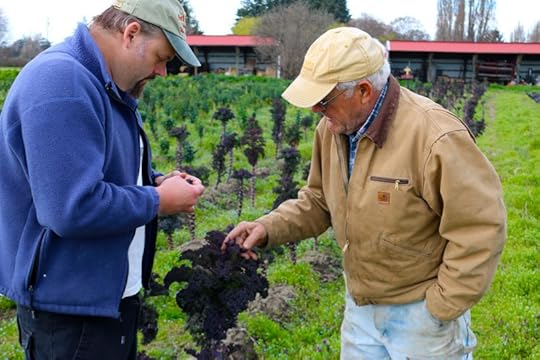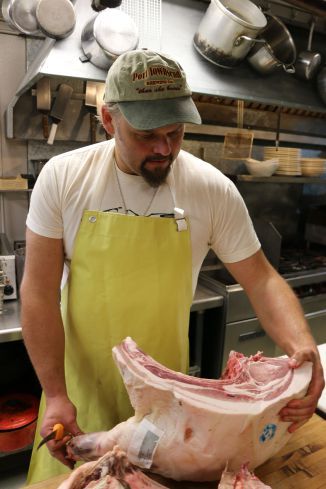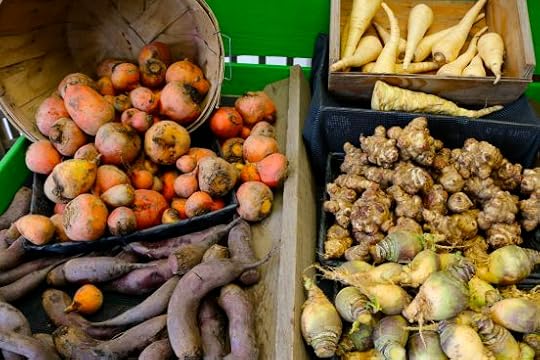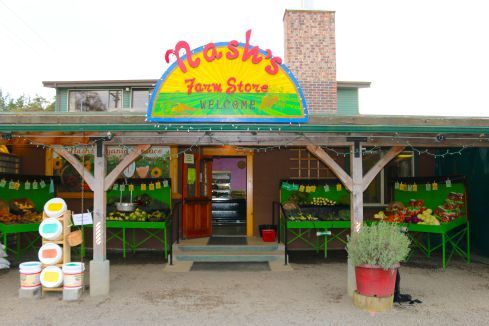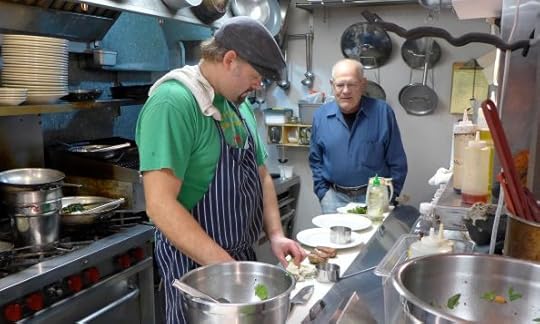The Ecosystem of Food: Interview with Nash Huber and Gabriel Scheuneman
In December, 2014, I interviewed Gabriel Scheuneman, owner and chef of Alder Wood Bistro and Nash Huber, farmer and owner of Nash’s Organic Produce. The interview took place during off hours at the Alder Wood Bistro, in Sequim, Washington.
Bob: What do you both do?
Gabriel: I run a small, local, seasonal, organic bistro. For us its all about living our values through our business — and for us that means buying local and seasonally and changing our menu and trying to keep the money in the community, using our local purveyors as much as possible.
Nash: From the business perspective, I share the same values. We are trying to keep the money in the community and provide right livelihood and grow good, clean food. We have some of the best land to manage on the planet. And we’ve got good water, year-round, and a wonderful climate. We grow food and provide a food shelter, and a food landscape for my community. That’s my goal. That’s what I try to do.
Bob: Each of you has strong Old World influences. Gabriel, you trained in Spain; Nash, you network extensively with the Slow Food Movement in Italy. How does this influence your approaches to preparing and growing food?
Gabriel: I grew up in California during the resurgence of “farm to table,” after the industrial revolution and huge mono-crop agriculture turned our food to something completely different. People like Alice Waters and a number of other California chefs really went back to the seasonal, local, organic and more of that focus – so that’s back to the Old World, because people always had always cooked that way in the past. For me, growing up in the Bay Area and having those resources close by and my travels through Europe and seeing that in action, where it’s been going on forever. Living in Spain and Switzerland and traveling throughout Western Europe and parts of Asia, I saw that people really focus on the season and cook within those seasons. The food tastes better; it’s fresher and you are more in touch with the cycles of seasons. The Mediterranean definitely influences my cooking here in the Bistro. We have a wood-fired oven, so we have pizzas and planked seafood that draws more from our local heritage on the Olympic Peninsula using alder and the fire for cooking. My influence in the cuisine I do is primarily Spanish, French and North African. I draw from the warmth and spices of North Africa and Spain which is strongly influenced by North Africa from being ruled for 700 years by the Moors. My own heritage is Northern European—Swiss and German— so more of the richer winter food of meat and potatoes, spaetzel and braised meats. That’s quite a broad influence.
Nash: I’ve not had an opportunity to travel much until the last few years – the farm has kept me kind of busy. But in traveling in, say, to Italy in the last ten years, was how much I was influenced by my upbringing in South Central Illinois in second and third generation immigrant community, German, Italian, Polish. Those were the people I grew up amongst. Farmers, and coal miner communities still lived by the values they brought over from the old country. So, the revolution we went through in this country in the last 50 years of the last century, where we commoditized everything and put everything on the Interstate and moved everything around the country in big trucks – that’s a very recent phenomenon. I think historically, we will look back on that 50 years from now and maybe shake our heads a little bit and wonder what the hell happened there? What I’ve seen in Europe is basically what I saw growing up – food being grown and consumed in the community. I started out farming, trying to go back to that tradition. That’s what I was looking for. And my vision has been guided by that all along. And just going to Italy a few times, looking and seeing has just reinforced that view. I could see that. I could see where that comes from and that’s why they are doing that. It’s local, it’s what they raise, it’s what they’ve got right now. And when we were growing up it was the same— that’s what we had to eat. And it was good food. It was clean food.
Bob: Gabriel, to achieve true “snout to tail” in a restaurant you must think of the kitchen as an ecosystem that constantly recycles food from the basic form that Nature provides it into products, down to the last morsel. How do you do that? In a business environment? In a production environment as busy as your kitchen?
Gabriel: For us, we are very fortunate to be close to Nash’s farm. It lets us create a closed loop. Our restaurant seats 40 people, in the summertime 70. We have one 90-gallon garbage can. We have no dumpster. But we have seven 20-gallon compost buckets. So we’re able to divert a huge amount of waste from our restaurant and bring it right back to the farm, where it’s recycled back into organic matter to grow the next crop. It’s both ecological and saves us money because we are not contributing to a landfill and we are contributing back to the nutrient base of Nash’s compost. That feels good and it makes sense too.
In terms of nose to tail, it’s a little trickier because we’ve had issues of people just not being open to the food that we want to cook all the time. Selling trotters and pate and head cheese is something that’s a little bit outside the norm for the majority of our customers, so we have to learn how to utilize it and, in some aspects spin the terminology and labeling of things to make it more accessible and not so much in their face. So we do a dish that’s a slow-braised pig’s head that incorporates the ears, tongue and cheeks. We make it into a beautiful roulade that’s braised overnight and its sumptuous and delicious and its braised pork. It’s nothing weird. But it’s parts that are not often utilized and we call it “crispy, braised pork.” It’s delicious and people love it. They don’t have to know that it comes from parts of a pig’s head. People eat Spam and compressed pork products all the time and that’s what they are eating too. Ours is just much less processed.
Bob: Nash, the farm is a true ecosystem process, especially in organic growing. How do you get past the obvious – seed to produce – and into the systems view of it – no waste and the ultimate form of recycling organic materials? What’s the thought process or the vision of stepping back and looking at the farm as an ecosystem.
Nash: That word vision is and important word and its become more important to me as get older. I’ll go back a little bit to what Gabriel was talking about there with the parts of the pig. We raise a lot of pigs and we sell a lot of pigs custom. The customer doesn’t want the head, the liver, the heart or the trotters. And so we’ve got this challenge. Here you’ve got a significant part of the pig. I know growing up on the farm, the headcheese that my grandmother made was prized, that was some of the best food there was. We always had fresh liver on slaughter day and the day after, and my dad just made a wonderful liverwurst sausage that I’ve just gotten back in to recreating in the past few months. It’s such a wonderful part of our diet. So it goes back to the previous question – as we changed how we look at life and we look at the systems in which we live – trying to make it more whole, as we try to be in synch with all those cycles and we begin to see those connections that are so important – how we structure our soil fertility program on the farm. We do not buy fertilizer. We grow our fertilizer. We grow cover crops. We make compost. You have to look at the whole system and you have to structure what you do within that concept, within that whole systems view. Otherwise, if you don’t do that, in a business sense, you have a bottom line problem. You have costs that should be on the positive side rather than on the negative side. It’s always a challenge to get that because over half of our business is retail, so communication to our customer base and helping them to understand the wholeness of what a farm is difficult. So many people are coming at it from the commodity viewpoint and the cheap price on the tag at the grocery store point of view.
Bob: Being innovators in something as basic as food means being an educator. How’s that going? Are people “getting it?”
Gabriel: We’ve been fortunate enough to grow every year, so people definitely see the value in local organic food. Sadly there’s a disconnect and a lack of education about the true costs of the price tag that Nash was just talking about at the grocery store. People don’t take into account the lack of nutrients in their supermarket chain carrots and potatoes and spinach that maybe cost a fraction of what Nash’s bunch of overwintered Bloomsdale spinach costs, but the nutritional value and the vitamins greatly exceed that of the chain produce. People don’t take into account the true costs, like visiting the doctor more frequently or issues of obesity and heart disease. These are epidemic in America and that’s not a cost they factor into their buying habits. It’s sad, and it’s a huge issue in America.
But people are beginning to accept it. Here in the Bistro, we do smaller portions of protein and larger portions of vegetables and legumes. We try to factor that price so that people see the value in that. That’s a continuing issue for us to work toward the perceived value of things. Our food takes more labor because we buy whole foods and not processed foods and so our labor costs are quite a bit higher than most restaurants here on the Olympic Peninsula. But we feel good about that. We are supporting our local economy and working with richer and more delicious food.
Nash: I think people are getting it. We are in the education business. Health is intimately wrapped up with what you eat as well as what you do. I see that in my customers – how people eat is directly tied to how they feel. You are what you eat. What Gabriel does is such an art form in that he adds so much flavor and value to the food that he prepares. I really see that as people learn and as they develop…I view my farm as a community resource and I’ve only come to that in the last five or 10 years. I definitely see the farm as a community resource not just as a food base, but as an art form and a way of understanding life and what life has to offer us. So it’s an ongoing struggle to make a profit, to pay the bills all the time and train employees and help our customers understand what good food is.
Bob: You have a long history of working together. It’s a collaboration. Nash’s products are always highlighted on Gabriel’s menus. What makes this collaboration work so well?
Gabriel: Nash came to me a while back telling me about his Dent corn. “Oh, you’ve got to try some of this Dent corn. We’ll get some over to you.” So, he fuels my inspiration. We started working with this polenta corn. We’ve worked with it a lot over this past year and have come up with a beautiful, silken polenta in which we incorporate goat cheese, and chicken stock and dairy and it’s luscious. So it’s inspiration that he fuels me with. If it’s not Nash, it’s other providers bringing me samples of crops they have – different beans and seeds like mustard seed. It’s an ongoing give and take, of collaboration with each other. In the past I’ve met with some of Nash’s farm managers and talked about small production crops that they can grow for me specifically. They grew some oyster plant and salsify. We just talk about what could be something new that they could focus a bit of energy on. It’s a relationship of mutually inspiring each other.
Nash: It’s interesting because Gabriel has an art of interpreting food and working with food that I’ve never seen before this close up. Having someone to take, say, the polenta corn—that Dent corn—which is a corn that looks a lot like the corn we used to grow when I was growing up, 60 years ago. You can’t find that corn anymore. Nobody’s growing it. It’s not readily available. Most of the corn is being grown for starch so it can be turned into alcohol. But this corn is a high-protein corn that’s still sweet. When you grind it up and make a polenta out of it, it still tastes sweet and it tastes like corn. It feels good when you eat it. I’m not sure many people have ever had that experience—eating a good polenta that, at the same time, is sweet and tastes like corn.
So, Gabriel sees things differently from how I see them and that’s really important. When you have a collaborative relationship where you have another person who is sensitive to what you’ve grown and labored at. Or, he will ask us to grow something, like the oyster plant and we’ll struggle to make it happen. That’s good information. It gives us a heads up about what is coming at us. It helps us see where the new trends are. His radar is a little sharper than ours.
Bob: Is there a “Pacific Northwest” cultural cuisine?
Gabriel: A lot of that comes from the Native tribes of the region. It has to do with salmon, the Ozette potato, and local foraging of wild foods. But it has sprinklings of flavors from all over the world. Here we have the Pacific Coast cuisine, that has a lot to do with the oysters that grow here and all the shellfish, the salmon that run throughout the year in our coastal waters and rivers, and the berries that grow here. We do wonderful things incorporating the local berries into salsas to top our alder-planked salmon. That’s very much a part of that Northwest cuisine. We use blueberries and blackberries from the local farms here. I’m excited about trying salal berries. I found that they are quite edible and tasty, so I’m learning more about the wild foods of the region. That’s part of my continuing education as a chef.
Nash: The cuisine is evolving. We went through a change in the last 50 years. I think there was a cuisine, say, 60 years ago. And then we entered commodity agriculture. And you could by everything you wanted, cheap, off the truck, in white plastic buckets. What Gabriel is doing and what other chefs are doing is changing that. They are using a wider variety of ingredients. We can do that. We have a wonderful climate here. We can have food year around here, off the land. Mushrooms, berries, salmon, the root crops, the greens like the Brussels sprouts, the collards, the kales, the cabbages. So we can have food here, year-round. Just coming back from Italy recently and eating there. I think you’d have a hard time finding a bad restaurant in Italy. It’s not hard to find a bad restaurant in this country, but in Italy, you’ve got to go out of your way and work hard to find one. That reflects a different attitude toward food and how they source food. And the vision and philosophy behind food.
Yes, it’s an evolving cuisine. And as we understand “local” more, and as we understand our climate more, and we work with our climate and work with our vision and work like Gabriel and I are in a collaborative environment where we feed off each other, and understand what the other person is trying to do and supply them with ingredients and inspiration. Stay tuned. It’s going to get more interesting.
Bob: The Dungeness Valley as a food source: Is there something in the water? What’s going on here?
Gabriel: Nash touched on it. We have a gentle, maritime climate, so we have crops throughout the year when a lot of people don’t. We have leafy green vegetables and cabbages and all the beautiful, sweet root crops throughout the winter. And now Nash is focusing on providing beautifully ground grains, so we have soft wheat, red wheat, and corn—a number of dry cereal crops too that a lot of farmers don’t have.
We incorporate those into our pizza crusts and our pastries and we have amazing access to the incredible diversity that Nash has cultivated over the years. We are incredibly fortunate to have that crop breadth to work with. It makes my job a lot easier.
Nash: The Dungeness Valley is a magic place, it really is. It’s got salt water almost on three sides of it. The Pacific Ocean gives us a mild winter. We get snow in the mountains that gives us water in the summertime for irrigation. It’s mild….I don’t want to make it sound too good or we’ll drive up land prices…I better stop while I’m ahead. We have food off the farm so that when Patti and I sit down to the table at night, virtually everything we eat came off the farm. And that’s just the way it is. Maybe that’s the way I am. We are blessed. We have this bounty.
Bob: When do we eat?
Photographs and text Copyright © 2015, Robert Steelquist. All Rights Reserved



